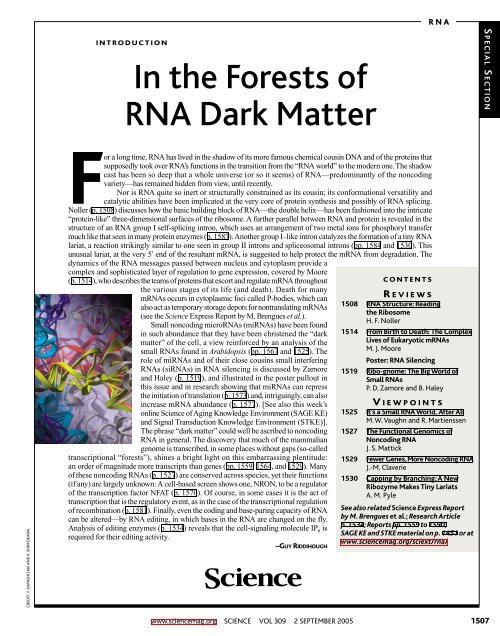THIS WEEK IN
THIS WEEK IN
THIS WEEK IN
You also want an ePaper? Increase the reach of your titles
YUMPU automatically turns print PDFs into web optimized ePapers that Google loves.
<strong>IN</strong>TRODUCTION<br />
T ITLE OF S PECIAL S ECTION<br />
In the Forests of<br />
RNA Dark Matter<br />
RNA<br />
S PECIAL S ECTION<br />
CREDIT: Y. HAYASHIZAKI AND K. SHIMOKAWA<br />
For a long time, RNA has lived in the shadow of its more famous chemical cousin DNA and of the proteins that<br />
supposedly took over RNA’s functions in the transition from the “RNA world” to the modern one. The shadow<br />
cast has been so deep that a whole universe (or so it seems) of RNA—predominantly of the noncoding<br />
variety—has remained hidden from view, until recently.<br />
Nor is RNA quite so inert or structurally constrained as its cousin; its conformational versatility and<br />
catalytic abilities have been implicated at the very core of protein synthesis and possibly of RNA splicing.<br />
Noller (p. 1508) discusses how the basic building block of RNA—the double helix—has been fashioned into the intricate<br />
“protein-like” three-dimensional surfaces of the ribosome. A further parallel between RNA and protein is revealed in the<br />
structure of an RNA group I self-splicing intron, which uses an arrangement of two metal ions for phosphoryl transfer<br />
much like that seen in many protein enzymes (p. 1587). Another group I–like intron catalyzes the formation of a tiny RNA<br />
lariat, a reaction strikingly similar to one seen in group II introns and spliceosomal introns (pp. 1584 and 1530). This<br />
unusual lariat, at the very 5′ end of the resultant mRNA, is suggested to help protect the mRNA from degradation. The<br />
dynamics of the RNA messages passed between nucleus and cytoplasm provide a<br />
complex and sophisticated layer of regulation to gene expression, covered by Moore<br />
(p. 1514), who describes the teams of proteins that escort and regulate mRNA throughout<br />
the various stages of its life (and death). Death for many<br />
mRNAs occurs in cytoplasmic foci called P-bodies, which can<br />
also act as temporary storage depots for nontranslating mRNAs<br />
(see the Science Express Report by M. Brengues et al.).<br />
Small noncoding microRNAs (miRNAs) have been found<br />
in such abundance that they have been christened the “dark<br />
matter” of the cell, a view reinforced by an analysis of the<br />
small RNAs found in Arabidopsis (pp. 1567 and 1525). The<br />
role of miRNAs and of their close cousins small interfering<br />
RNAs (siRNAs) in RNA silencing is discussed by Zamore<br />
and Haley (p. 1519), and illustrated in the poster pullout in<br />
this issue and in research showing that miRNAs can repress<br />
the initiation of translation (p. 1573) and, intriguingly, can also<br />
increase mRNA abundance (p. 1577). [See also this week’s<br />
online Science of Aging Knowledge Environment (SAGE KE)<br />
and Signal Transduction Knowledge Environment (STKE)].<br />
The phrase “dark matter” could well be ascribed to noncoding<br />
RNA in general. The discovery that much of the mammalian<br />
genome is transcribed, in some places without gaps (so-called<br />
transcriptional “forests”), shines a bright light on this embarrassing plentitude:<br />
an order of magnitude more transcripts than genes (pp. 1559, 1564, and 1529). Many<br />
of these noncoding RNAs (p. 1527) are conserved across species, yet their functions<br />
(if any) are largely unknown: A cell-based screen shows one, NRON, to be a regulator<br />
of the transcription factor NFAT (p. 1570). Of course, in some cases it is the act of<br />
transcription that is the regulatory event, as in the case of the transcriptional regulation<br />
of recombination (p. 1581). Finally, even the coding and base-paring capacity of RNA<br />
can be altered—by RNA editing, in which bases in the RNA are changed on the fly.<br />
Analysis of editing enzymes (p. 1534) reveals that the cell-signaling molecule IP 6 is<br />
required for their editing activity.<br />
–GUY RIDDIHOUGH<br />
CONTENTS<br />
R EVIEWS<br />
1508 RNA Structure: Reading<br />
the Ribosome<br />
H. F. Noller<br />
1514 From Birth to Death: The Complex<br />
Lives of Eukaryotic mRNAs<br />
M. J. Moore<br />
Poster: RNA Silencing<br />
1519 Ribo-gnome: The Big World of<br />
Small RNAs<br />
P. D. Zamore and B. Haley<br />
V IEWPO<strong>IN</strong>TS<br />
1525 It’s a Small RNA World, After All<br />
M.W.Vaughn and R. Martienssen<br />
1527 The Functional Genomics of<br />
Noncoding RNA<br />
J. S. Mattick<br />
1529 Fewer Genes,More Noncoding RNA<br />
J.-M. Claverie<br />
1530 Capping by Branching:A New<br />
Ribozyme Makes Tiny Lariats<br />
A. M. Pyle<br />
See also related Science Express Report<br />
by M. Brengues et al.; Research Article<br />
p. 1534; Reports pp. 1559 to 1590;<br />
SAGE KE and STKE material on p. 1451 or at<br />
www.sciencemag.org/sciext/rna/<br />
www.sciencemag.org SCIENCE VOL 309 2 SEPTEMBER 2005<br />
1507
















